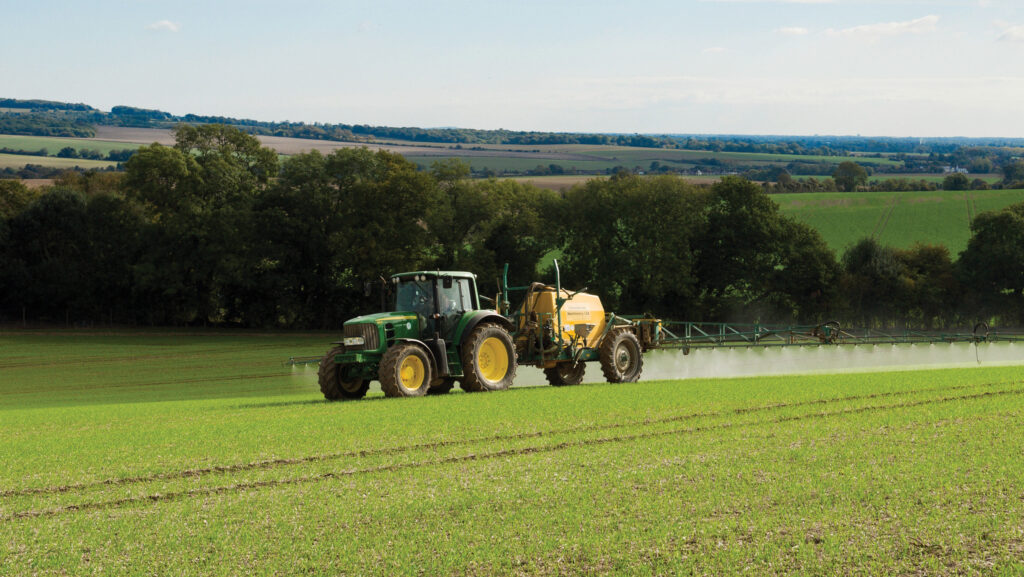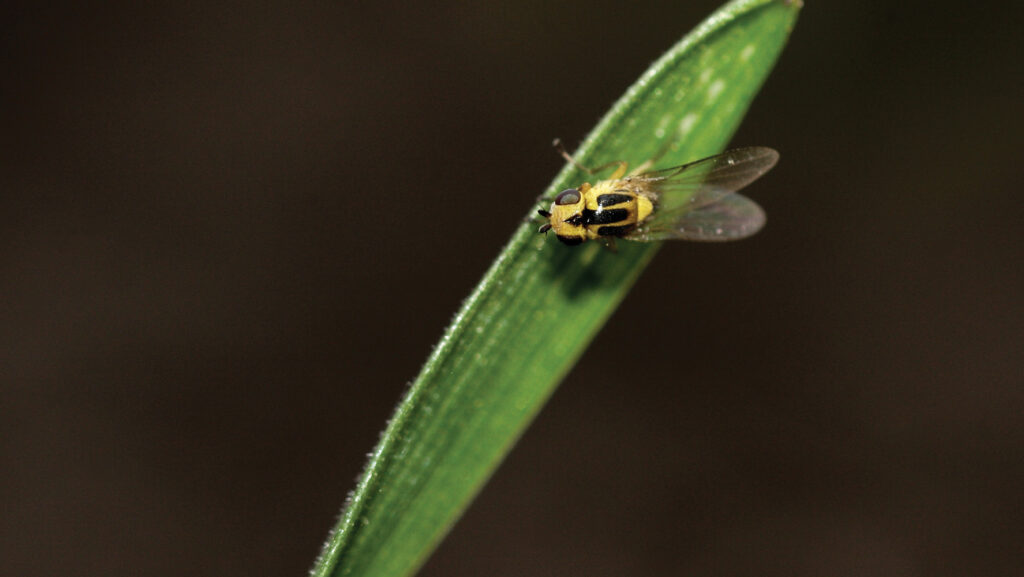Crop Watch: High numbers of aphids, CSFB and gout fly
 © Tony Cortazzi/Alamy Stock Photo
© Tony Cortazzi/Alamy Stock Photo Warm conditions in a near perfect autumn has seen a rise in pest pressure for winter cereals with concerns over barley yellow dwarf virus and gout fly, especially in early drilled fields.
Cabbage stem flea beetle is also proving troublesome, especially in OSR crops where dry conditions have seen growth stall.
See also: How growers returned environmental schemes back to cropping
West
Ben Allard, Pearce Seeds (Dorset, Wiltshire and Somerset)
Autumn drilling is now in full swing, with many nearly finished – and what a difference it is compared with last year.
Yes, some have been drilling wheat earlier than I would like in certain fields, but I can’t blame them, as the memory of last year still haunts many of us.
The thought remains firmly ingrained that once the rain starts again, it won’t stop, but the drills and sprayers certainly will.
Seed-beds this year have been fantastic for all autumn-sown crops. The first to take advantage of these conditions were the vital grass reseeds.
These have established really well, many of which will be critical to perform strongly next spring due to the forage shortage resulting from the prolonged drought.
Last year was a nightmare season for harvesting maize, with operations carrying on all the way into November. This year, however, harvest started in late August and most finished by late September.
While yield and quality were very variable, the blessing of an early harvest has meant many have been able to make the most of the good weather by establishing cover crops and cash crops in fantastic seed-beds – something that is often a challenge in a normal maize year.
Cover crops planted behind early harvested maize are looking fantastic, with great established biomass and deep root structures starting to form.
These will certainly help retain nutrients, reduce soil run-off, and armour the soil for whatever the winter brings!
Pest pressure
With winter wheat and barley being sown into fantastic seed-beds and crops rapidly emerging, what could possibly go wrong?
Well, as a result of this early autumn drilling window, aphids and gout fly have been found across the region in large numbers.
The risk of barley yellow dwarf virus (BYDV) is now increasing due to the early sown crops, with many soon to require an insecticide to help bring populations under control.
While I’m never a fan of using insecticides, we have to be realistic about the threat that BYDV poses to winter cereals.
With high yield loss potential, coupled with poor grain prices, there is little margin for error this season.
Gout fly and their eggs are also clearly visible this year, particularly in sheltered fields around woodlands.
Helping the crop to establish well and tiller strongly will help mitigate the impact from gout fly, which was evident last year, but could be worse this season given the number of eggs being seen.
It will be interesting to see how well the pre-emergence herbicides perform despite the dry spell.
I’ve often been asked whether we should drop the pre-emergence and move into a post-emergence position once there is more moisture, but the answer is no.
In high grassweed pressure fields, it’s key we get off to a good start and stick to the plan to stay on top of the weed burden.
Oilseed rape (OSR) crops have now all received their graminicide, my go to choice is Falcon (propaquizafop), with the addition of a water conditioner to really knock the volunteer cereals back.
Overall, OSR crops are looking okay. However, I do believe the dry weather has slowed them down, making them more vulnerable to the increasing cabbage stem flea beetle (CSFB) pressure.
Some plants have clearly taken a beating from the pest. I’d certainly like to see a bit more rain in the forecast to help the OSR push on and outgrow the current damage being caused by CSFB.
East
Harriet Bateman, Prime Agriculture/AICC (West Norfolk, Cambs, south Lincs)
A prolonged dry spell has allowed good progress with drilling. The soil is well structured, and despite the lack of rainfall seed-beds are working down well, with most growers making good use of settled weather conditions to keep on top of autumn workloads.
Good seed-beds are allowing growers to drill at a safe depth with seed well covered with tilth to protect it from the pre-emergence herbicides.
Although soils are dry on the surface there is moisture underneath and we remain hopeful that residual herbicides will perform effectively.
Most areas received some rainfall in early October, encouraging a fresh flush of grassweeds that is likely to continue into early November.
However, concerns remain for fields drilled in September where blackgrass risk is high. These may have missed the benefits of a longer stale seed-bed period, and weed control is now heavily reliant on herbicides – a challenge where soil moisture is limited.
Earlier-sown wheat from late September is emerging well, and peri-emergence sprays are being considered where grassweed pressure is high.
Aphids
Aphid activity requires careful monitoring in both wheat and barley, with bird cherry-oat aphids being the primary concern.
BYDV control should be considered at the one to two leaf stage, when aphid populations are present in the crop.
Use guidance such as the AHDB BYDV Management Tool to predict aphid activity and guide the timing of insecticide applications. These sprays will also incidentally reduce gout fly risk in earlier-drilled crops.
Oilseed rape crops are a mixed bag. The earlier August drilled crops generally look strong, with good rooting helped by the dry, friable soils.
However, some September sown crops, drilled into dry conditions are of a concern, particularly as these were attacked by CSFB during a period of slow growth.
Continue monitoring crops for phoma lesions; treatment should be applied once 10% of plants show symptoms, especially in more susceptible varieties. The AHDB phoma forecast is a useful guide for timing.
Sugar beet lifting is progressing well under the dry conditions, and sugar contents are notably high this year, well above average in many cases.
Ground travel remains good, and some are cultivating and drilling directly behind the harvester where soil moisture allows.
Potato harvest is a mixed bag. Yields are highly variable, largely where differences in water availability and planting conditions.
Some growers are reporting bold tubers and strong yields, while others are seeing disappointing results, particularly where crops struggled under the dry conditions.
The market remains flat, adding to the sense of frustration for those facing below-average returns.
South
Anna Dunford, Hampshire Arable Systems/AICC (Hampshire, Surrey and Isle of Wight)
Drilling is well under way or complete for most farms; this now leaves growers looking ahead at the settled forecast with mixed feelings.
To have held back the drills would have been a bold move given the last few autumns, but we now have a large proportion of early drilled crops to manage.
The autumn drilling campaign has been seamless so far, providing growers with great opportunities to create stale seed-beds, long windows in which to drill, roll and apply pre-emergence herbicides.
Storm Amy bought some well-timed rain to activate recently applied residuals.
Top up herbicide applications are being utilised where required – an opportunity many growers haven’t had for the last few years.
Stacking and sequencing chemistry with an understanding of the longevity of actives is key to achieving long lasting control.
Aphids and gout fly eggs are easy to find on early drilled crops, and hitting optimal control timing for the latter is tricky, often not coinciding with the BYDV spray.
Crops should be closely monitored for aphids, and the accumulation of day degrees and, therefore, the threshold for treatment will come round quickly.
Gout fly

© Blackthorn Arable
The forecasted warm, dry settled weather will induce a lengthy egg laying period for gout fly and possibly result in a high number of gouted tillers.
This is not always a problem, provided the crop tillers well and gets away in the spring.
An early nitrogen application, rolling and tiller manipulation with growth regulators in the spring is perhaps more effective than insecticides.
With a huge amount of wheat drilled in the last fortnight, we can be hopeful that pest pressure will be diluted.
The recent rain has given any struggling oilseed rape crops a helping hand, and those that had stood still for a number of weeks are now beginning to cover the ground.
Volunteers are generally dealt with and cut off for clethodim applications for blackgrass and ryegrass is approaching.
The first phoma lesions of the season have been spotted on early August sown crops, bringing our thoughts round to timely fungicide applications.
Phoma lesions usually appear two to three weeks after spore release, so crops are likely to reach threshold by mid-October.
Smaller crops and particularly varieties with low stem canker disease resistance ratings of seven and below, should be monitored and treated when the 10-20% threshold is reached.
An application of prothioconazole will also add light leaf spot protection.
North
Stephen Bell, Fane Valley (Northern Ireland)
The early harvest has provided an excellent window to establish cover crops and oilseed rape under favourable conditions, while also allowing for effective use of stale seed-beds as a starting point to manage grassweeds in cereal rotations.
Oilseed rape acreage has more than doubled in the local area this season, with most crops sown from mid-August to early September.
Crop establishment is variable, with most between the four to six leaf stage. Keep a close eye out for slugs in smaller, more backward crops, and reapply pellets where needed, particularly following recent rainfall.
Weed control has generally been effective, particularly where pre-emergence applications coincided with the showery weather in early September.
An autumn tidy-up will be required in some fields, especially where cleavers, chickweed, and shepherd’s purse are prevalent and advancing beyond the three-leaf stage.
Volunteer cereals are widespread and, in many cases, growing faster than the rape; these should be sprayed off once ground conditions allow, if not already treated.
Tailored brassica foliar nutrition, together with phosphite and fungicide applications, will be made over the next few weeks to encourage rooting, enhance crop health, and strengthen resilience heading into winter.
Cereals
Effective grassweed control remains a key priority in wheat and barley, targeting brome, Italian ryegrass, and annual meadow grass.
Residual herbicides based on flufenacet/pendimethalin and diflufenican mixtures should be applied within 48 hours of drilling, with post-emergence applications topping up to 360 g/ha flufenacet where needed.
Note that Liberator is approved only for pre-emergence use in oats at 0.3 litres/ha.
Remember, this is the final season for sales of flufenacet-based products in Northern Ireland, with the last purchase date set for 10 December and final on-farm use permitted for a year later.
Plan ahead and secure stocks for next autumn before the final sale deadline.
BYDV-tolerant barley varieties have proven popular this year, accounting for over half of barley seed sales, helping to mitigate virus pressure associated with early drilling.
Recent local monitoring indicates an increase in bird cherry-oat aphid migration over the past fortnight, though overall levels remain lower than last year and below the long-term average.
With T-sum 170C now reached for crops emerging in late September, crops are at increased risk and should be monitored and treated accordingly.
Overall, there has been good progress with autumn drilling. Crops look promising, and with dry, settled weather forecast, there should be an excellent opportunity to continue fieldwork and harvesting throughout the rest of the month.
Tip of the week
Continue monitoring OSR crops for phoma lesions; treatment should be applied once 10% of plants show symptoms, especially in more susceptible varieties.
Harriet Bateman

